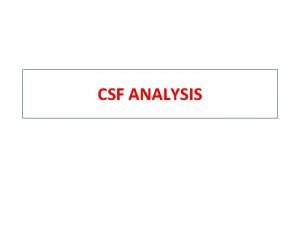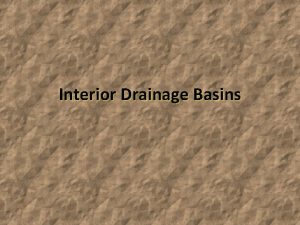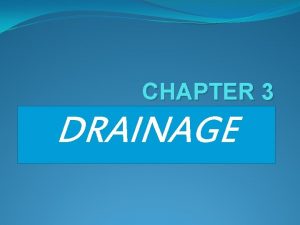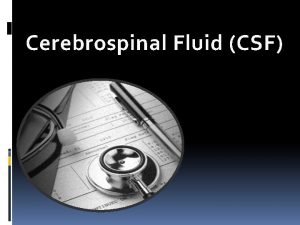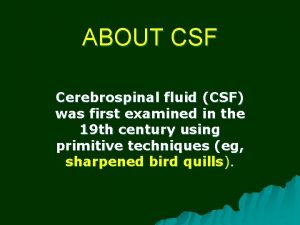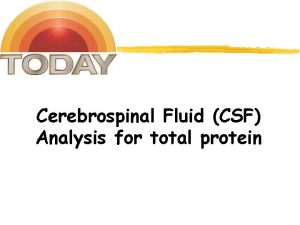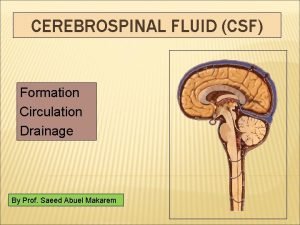Managing External Drainage of CSF Practical tips for

















- Slides: 17

Managing External Drainage of CSF: Practical tips for nursing care WORLD FEDERATION OF NEUROSCIENCE NURSES

Objectives • To provide an overview of basic principles of CSF diversion including the following: – Indications for CSF drainage – Types of CSF diversion systems – Nursing care and management of EVD’s and lumbar drains

Why do we drain CSF? • To treat high pressure states in selected patient – – Control elevated intracranial pressure by draining CSF Normal Pressure Hydrocephalus Obstructive hydrocephalus Communicating hydrocephalus • To treat or prevent leaking of CSF when the dura has been surgically opened • Shunt infections (externalize drainage while treating infection)

Options for CSF diversion

What is an external ventricular drain (EVD)? • A drain that is placed surgically into the ventricles • Generally tunneled and sutured to the scalp – Always document the opening pressure if performed at bedside • Allows CSF to drain into a sterile bag • Can be helpful in treating: – Elevated intracranial pressure – Diverting CSF to treat an infection – Clearing blood products from the ventricles

External ventricular drain nursing care -Level the drain to ordered level -Observe drainage hourly -Call a supervising provider for drainage less than or more than expected values -If transduced, treat elevated ICP by opening the drain when the pressure exceeds the prescribed level

External ventricular drain nursing care -Clamp if out of bed/ re-level with bed adjustment -CSF sampling is no longer considered standard of care -Dressings have not been found to reduce the risk of infection -Observe insertion site for signs infection or CSF leakage

What is a lumbar drain? • A closed sterile drain system that is placed in the subarachnoid space to drain CSF • Generally placed at L 3 -4 (spinal cord ends at T 12 -L 1) • Common indications include: – Diagnostic evaluation of idiopathic intracranial HTN – Diversion of CSF after dural tear or CSF leak – Diversion during treatment of a shunt infection – Thoracolumbar aortic aneurysm to improve spinal cord perfusion

Lumbar drains nursing care - Level the drain to ordered level - Observe drainage hourly - Call if drainage exceeds or is less than expected values - Educate the patient to call for help before getting out of bed (clamp drain) - Re-level with any bed adjustment

Lumbar drains nursing care • Consider restraints/family sitter if unable to follow instructions • Transparent dressings should be in place and observed every shift • Avoid contamination during peri-area care • If required, dressing changes should be sterile • Observe insertion site for signs infection, leakage of CSF

Sampling CSF for culture (example) • ALWAYS follow your hospital procedures • Don clean gloves, mask • Prep side port below the buretrol with two betadine prep pads and allow to dry 3 minutes (ensure sampling port remains sterile) • Insert needle into side port below the buretrol port and withdraw sample at least of 1 ml of CSF • Replace needle with sterile blue cap • Label specimen with date/time collection and nurses signature • Send to lab for analysis with lab requisition

Nursing care of the all CSF drains • Assess insertion site every four hours for signs/symptoms of infection or signs of CSF leakage around insertion site • Assess patient every four hours for signs/symptoms of meningeal irritation • Check integrity of dressing every shift and reinforce if needed • Observe the drainage system, color and clarity of CSF drainage hourly

Nursing care of the drain • Maintain the integrity and sterility of the closed system by keeping all connections tight • If system becomes disconnected at catheter site, clamp catheter with a sterile clamp and notify physician or nurse practitioner • Assure tubing is not kinked • NEVER INJECT ANYTHING INTO THE SYSTEM

Troubleshooting the EVD or lumbar drain • No CSF drainage ( < 5 ml/hr) when drain open at prescribed level – Check system integrity for loose connections (never reconnect a broken drain- turn the stop cock proximal to the break to off, cover site with sterile 4 x 4 and call neurosurgery) – Confirm all stopcocks open – Check drain patency by briefly lowering the drain, observe for dripping – Document troubleshooting measures – Call neurosurgery if still no drainage

Serious complications from over-drainage

What NOT to do…. . • Never treat a lumbar drain or EVD like a foley catheter – Too much drainage can cause intracerebral hemorrhage or herniation • Never disconnect/open the system – This can cause meningitis, pneumocephalus • Never let patients get out of bed without clamping the system – Educate patients/families about the dangers of overdrainage – re-level after all bed adjustments

Summary • CSF drains are an important treatment strategy for high pressure states and diverting CSF during shunt infection or after durotomy • External sites and drainage must be observed hourly • Care should be taken to maintain the drain at the prescribed level • Patients should be assessed routinely for any change in neurological assessment
 Drainage nursing
Drainage nursing Nccco practical exam layout
Nccco practical exam layout Small business management
Small business management External-external trips
External-external trips Datorkunskap för nybörjare
Datorkunskap för nybörjare Tack för att ni har lyssnat
Tack för att ni har lyssnat Treserva lathund
Treserva lathund Ekologiskt fotavtryck
Ekologiskt fotavtryck Läkarutlåtande för livränta
Läkarutlåtande för livränta Inköpsprocessen steg för steg
Inköpsprocessen steg för steg Påbyggnader för flakfordon
Påbyggnader för flakfordon Tack för att ni lyssnade
Tack för att ni lyssnade Egg för emanuel
Egg för emanuel Tack för att ni har lyssnat
Tack för att ni har lyssnat Tidbok för yrkesförare
Tidbok för yrkesförare Rutin för avvikelsehantering
Rutin för avvikelsehantering Vad är vanlig celldelning
Vad är vanlig celldelning Kontinuitetshantering
Kontinuitetshantering


















